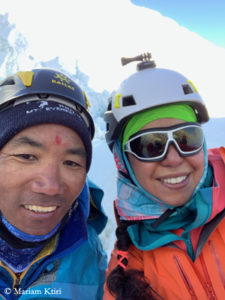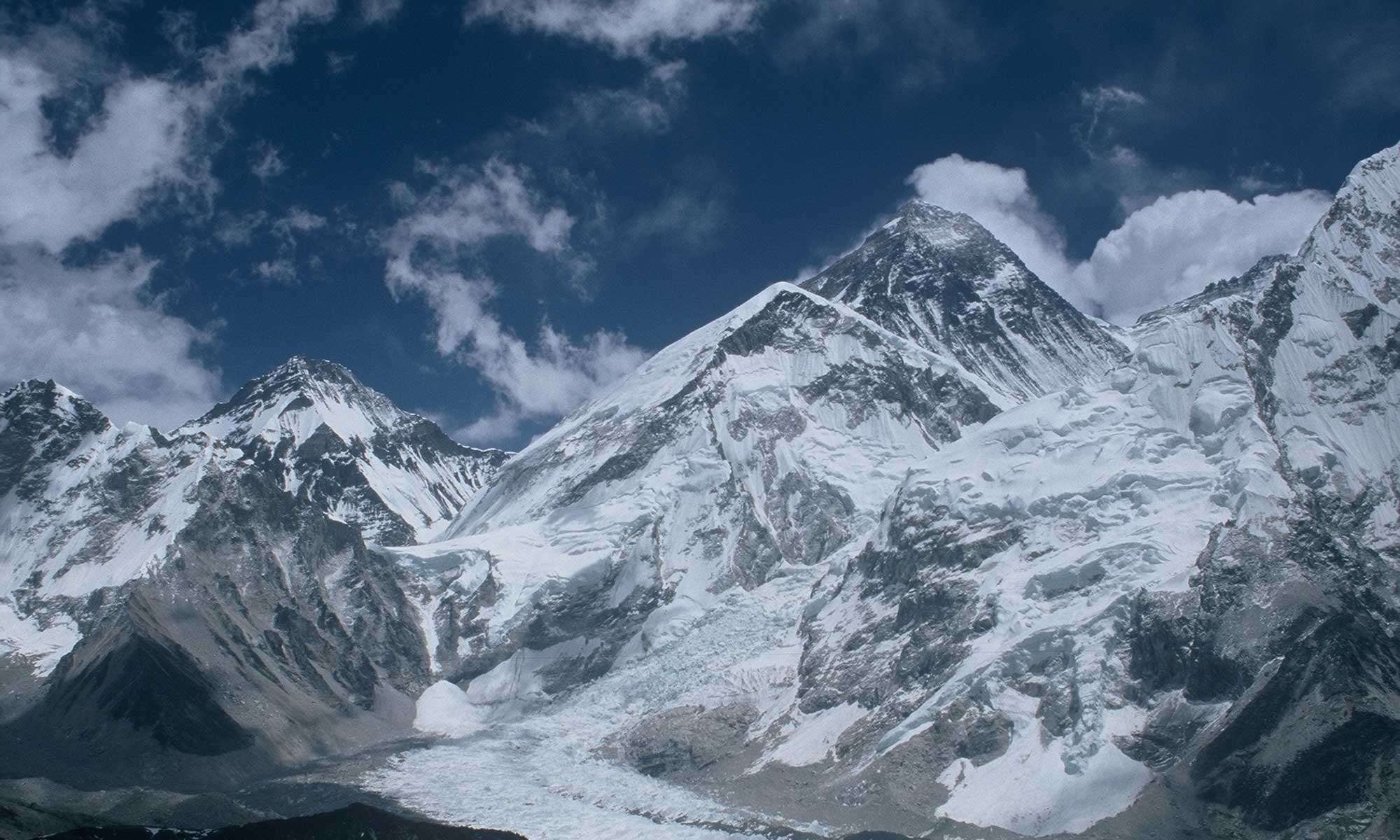The whole world has seen the queue of people on the Mount Everest summit ridge, Mariam Ktiri got stuck in it. On 22 May, the German-Moroccan had reached the summit of the highest mountain on earth already in the night, at 2.35 am local time. On her descent she was caught in the traffic jam that became public through Nirmal Purja’s picture and made headlines all over the world. “Shortly below the summit, the masses ascended towards us. Many of the people were extremely slow. You could see that they were completely exhausted. It took us about an hour and a half to get below the Hillary Step,” Mariam tells me. “Thank God I still had enough oxygen. My Sherpa checked this all the time. At that moment I wished there was a cop to stop the people and say: ‘Wait until those who come from above have climbed down! Everything else makes no sense.'”
“Strange mood”

Ktiri was en route with the US expedition operator “Climbing The Seven Summits” (CTSS). Already the day before, the group had got into an “incredible traffic jam” above Camp 3, as Mariam reports. According to her words, some more teams were waiting for their summit chance at the South Col. They had wanted to climb the summit already on that day, but had renounced it due to the bad weather: “There was a strange mood there.” Because of the many summit candidates, the CTSS mountain guides decided to leave between 5.30 pm and 6.30 pm and not, as usual, at 9 pm.
“We had full moon, a beautiful light. It was so quiet, I could only hear my breath,” Mariam describes her ascent. “It was magical.” And extremely cold – so cold that great emotions hardly came up when she reached the highest point at 8,850 meters. “I thought: Wow, now I’m at the highest point on earth, incredible,” Ktiri remembers. “But at the same time I had in mind: I have to remain concentrated, I still have to descend.”
On short rope in the Khumbu Icefall
Shortly after she had left the summit with her Sherpa to climb down, the disillusionment followed in the traffic jam. “I thought: We set off so early, we didn’t even make real breaks. We simply climbed up the mountain in a concentrated manner to avoid this situation. And now on the way back we were confronted with it,” says Mariam, “I was angry that people don’t think rationally. I tried to signal to those who were coming towards me: Please wait! But they didn’t react.”
According to Ktiri, the main problem on Everest are those who actually should not be there due to a lack of climbing experience: “There were some who didn’t have a clue. I have seen people who were dragged by their Sherpas on the short rope already in the Khumbu Icefall. If someone can’t walk by himself at this point, he is entirely out of place and should turn back.” Mariam hopes that the operators will introduce performance tests to check their clients’ mountaineering skills. “The people without a clue are a risk for everyone: for themselves – okay , that’s their problem – but also for the others.
Lhotse attached
One day after her summit success on Everest, Ktiri scaled the neighboring 8,516-meter-high Lhotse with her Sherpa. “I’m so glad I climbed Lhotse too,” says Mariam: “It was like a reward after the frustration at the traffic jam on the Everest descent. On Lhotse on 23 May, there were maybe a dozen mountaineers on the route. That was simply beautiful – apart from the corpse (of a mountaineer who died there earlier), which sits a few meters below the summit.”
The German-Moroccan had already been confronted with death during her ascent on Everest. On the Lhotse flank, Ktiri had passed the body of Bulgarian Ivan Tomov, who had died a few days earlier on his descent from Lhotse, apparently of a high-altitude cerebral edema: “It looked as if he was looking at the landscape. I was shocked.” The feeling intensified a little later when she met a group of Sherpas, carrying a body down. “His foot touched me, it was hard as stone. Then it became clear to me that it was a dead man,” says Mariam. “After that I became quite slow.” Even though she was psychologically upset, she didn’t think about turning back, says Ktiri. She was focused on her big goal.
Seven Summits within twelve months

With the Everest summit success Mariam completed her collection of the “Seven Summits“, the highest mountains of all continents. And this within a year: Before Everest, the highest mountain in Asia, Mariam had scaled Denali (North America, 6,194m, 28 May 2018), Elbrus (Europe, 5,642m, 13 August 2018), Kilimanjaro (Africa, 5,895 m, 24 September 2018), Mount Vinson (Antarctica, 4,897m, 16 December 2018), Aconcagua (South America, 6,962m, 12 January 2019) and the Carstensz Pyramid (Oceania, 4,884m, 23 February 2019).
Mariam has a Moroccan and a German passport: “I identify with both countries. One is my home, the other my adoptive country”. Ktiri grew up in the Moroccan city of Casablanca. At the age of 18, she came to Augsburg, Germany, to study. The management consultant then lived in Munich for twelve years. There she discovered her passion for mountaineering. “What do you do in Munich? You go into the mountains,” says Ktiri. “Over time, my ambitions have grown.” At the end of 2018, she moved to Bern, Switzerland: “Here the mountains are more nearby and higher. That was simply more efficient for acclimatization.”
Encouraging Arab women
The Seven Summits were “the project of my life until now,” says Mariam, “mentally, it made me very, very strong. I proved: If you have a goal in mind and you concentrate on it, above all follow it with discipline, you will always find a way to achieve it. This applies not only to the mountains, but also to your private or professional life.” What she has achieved in the “strongly male-dominated field of mountaineering” should also encourage other Arab women, says Ktiri: “Islam, our culture is the one thing that we can respect. But we can also have big dreams and realize them.”




